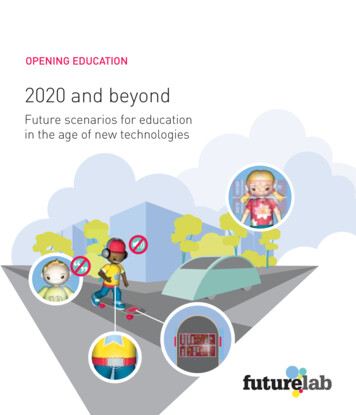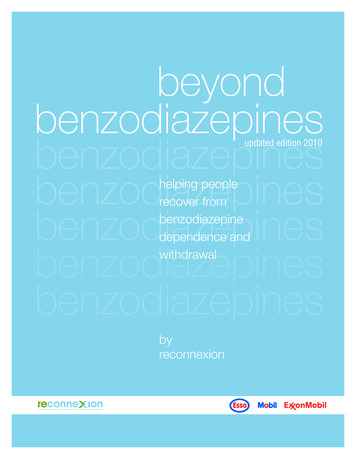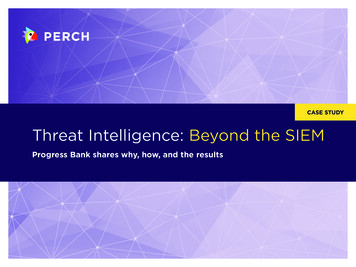
Transcription
OPENING EDUCATION2020 and beyondFuture scenarios for educationin the age of new technologies
This publication is available to download from the Futurelab website –www.futurelab.org.uk/openingeducationAlso from Futurelab:Literature Reviews and Research ReportsWritten by leading academics, these publications provide comprehensivesurveys of research and practice in a range of different fields.HandbooksDrawing on Futurelab’s in-house R&D programme as well as projects fromaround the world, these handbooks offer practical advice and guidance tosupport the design and development of new approaches to education.Opening Education SeriesFocusing on emergent ideas in education and technology, this series ofpublications opens up new areas for debate and discussion.We encourage the use and circulation of the text content of thesepublications, which are available to download from the Futurelab website –www.futurelab.org.uk/resources. For full details of our open accesspolicy, go to www.futurelab.org.uk/policies.
1Introduction32The structure of the paper53Future scenarios64Key challenges for education275Future visions – when digital meets biomedical316Sources and further reading33Hans Daanen and Keri FacerFuturelab 20072020 and beyond : Future scenarios for education in the age of new technologiesContents01
ForewordWhat is the Opening Education series?Opening Education is Futurelab’s ‘blue skies’ publications series. As its namesuggests, this series is intended to open up areas for debate; to provoke, tochallenge, to stimulate new visions for education.2020 and beyond : Future scenarios for education in the age of new technologiesThe ideas and arguments presented in these publications are generated ina variety of ways – through events and consultations with thinkers,practitioners and policy makers from a variety of sectors, through thoughtexperiments and visioning workshops, and as unexpected ‘side effects’ of theresearch and development activity that goes on at Futurelab on a day-to-daybasis. The series complements our evidence-based publications by offeringa space to propose new ideas that may not yet be ready for implementationor rigorous evaluation.02Why publish this series?All the research into innovation in a range of sectors suggests that having asuperfluity of ideas is essential for growth and development – education isno different. We need to have a surplus of potential ideas, visions and plansso that we have a range of strategies to draw on when we face the seriouseducational challenges that social, economic and technical change presentsus with. Not all ideas will become a reality, not all ideas will survive in theform in which they were first presented, but what cannot be denied is thateducation, and educators, need to know that there is scope to dream; to thinkabout new approaches and different ways of doing things; to know that theways we do things now will not be always and forever the same.It is in this spirit that we publish these ideas. They are experimental andexploratory, both in their arguments and in the forms in which we publish– they don’t all look the same, feel the same, say the same thing. They all,however, attempt to open up a new area for debate and for action, and we lookforward to hearing from you and working with you to determine their fate.Keri FacerResearch Director
1. IntroductionAt the present time the UK education system is witnessing a rash ofcrystal ball gazing. The Education 2020 report provides a vision forpersonalised learning for the next 13 years; the Building Schools for theFuture programme is engendering debates about the institutions andstructures of schooling for the next 50 years; and the 21st century curriculumreviews at QCA are generating discussions about the purpose and functionof education for the next 100 years. These discussions are not restricted tothe UK; since the late 1990s nation states around the world, and internationalorganisations such as the OECD and UN, have been exploring the future ofeducation in the 21st century.This publication is intended to challenge and disturb some of the assumptionsunderlying these discussions by reviewing current predictions about thedevelopment in capacities of digital technologies between now and 2020.In producing this brief paper, we want to ask the questions: To what extent are we prepared, as a society and as educators, for themassive changes in human capabilities that digital technologies arelikely to enable in the next 13 years? To what extent can we, as educators, help to shape the developmentsof technology in order to enhance human development?Predicting the future, of course, is notoriously unreliable. We only have to lookback to the 1970s to witness the prediction that only three computers wouldbe required worldwide, for example; or to the 1960s to witness predictionsthat we would shortly be living on the moon in fetching silver jumpsuits. Thepace of technological change is both more rapid than we can ever predict, andmonumentally slower than we had thought possible. This is not only becauseit is sometimes harder to achieve the breakthroughs that we had intended,or indeed easier because developments in one field unexpectedly assistresearchers in another (think of the implications for human genomics of themassive increase in computer processing power over the last ten years).2020 and beyond: Future scenarios for education in the age of new technologies To what extent are our future visions for education based uponassumptions about humanity, society and technology that are nolonger valid?03
It is also because technologies enter into already existing social spaces– they are shaped by the existing social practices, human interactions andvalues that they encounter outside the laboratory. Again, we only have to lookto the history of the record player to see how social practice can transforma technology – this device was originally intended as a personal recordingmachine rather than a replay tool which would spawn an entire industry andtransform musical practices around the world.Why, then, should educators consider some of the current predictionsfor developments in digital technologies?2020 and beyond: Future scenarios for education in the age of new technologiesIf educators are to shape the future of education (and not have it shapedfor them by external technical developments) it is crucial that we engagewith developments in digital technologies at the earliest stages. We need tounderstand what may be emerging, explore its implications for education,and understand how best we might harness these changes. Without this earlyengagement we risk, as always, being the Cinderella sector of the technologyworld – constantly receiving the hand-me-downs from the business, defenceand leisure industries and then trying to repurpose them for educationalgoals. Without this early engagement, we also risk designing educationalpractices and approaches that will be rendered obsolete and anachronistic inthe context of new human-technological capabilities.04As Douglas Adams once observed, “the best way to predict the future isto build it”. We need to know the building blocks available to us as educatorsin the near future in order to know how we might use them and develop themfor education.
2. The structure of the paperThis paper identifies five key areas where we believe there are likely to bedevelopments in the field of digital technologies which are of potential interestto educators. These areas are: personal devicesintelligent environmentscomputing infrastructuresecurityinterfacesWe also, however, wanted to explore a range of predictions at thefringes of certainty and which explore the interface between digital andbiomedical developments. These are addressed in a separate section,entitled the ‘far future’, and should be treated with caution. The reason forincluding this section, however, is that these ‘visions’ represent the currentimaginative (or distopian) possibilities being explored by the computing andbiomedical industries.Finally, as we intend the paper to act as a prompt for discussion and action,we identify a series of recommendations and questions for educators, policymakers and developers.2020 and beyond: Future scenarios for education in the age of new technologiesIn each of these areas we identify the overarching ‘big message’ offeredby developments in the field; we offer imaginary scenarios of how thesedevelopments may translate into everyday experiences; and we then exploresome of the implications of these developments for educational objectives,institutions and practices. In each section we also flag up the indicative R&Dthat is currently going on in universities and corporations which will feedinto this field. Clearly, many of the scenarios we envisage could be recastas distopias – and indeed, one of the intentions of this paper is to provokediscussion about what new values and rights we may want to develop in orderto constrain or enable certain developments. The predictions in each of theseareas are based on relative consensus amongst experts and organisationsin the computing industry. They are not considered ‘way out’ by mostcommentators and would not be seen to be at the limits of credibility withina 13-year timescale (ie by 2020).05
3. Future scenarios2020 and beyond: Future scenarios for education in the age of new technologies3.1 Personal devicesBy 2020, digital technology is embedded and distributed in most objects. Allpersonal artefacts – your keys, clothes, shoes, notebook, newspaper – havedevices embedded within them which can communicate with each other. Asa result, we will interact with these technologies in ways which are moreseamlessly and invisibly integrated into normal activities.06As you walk down the street of a new city, directions in your ear give guidanceon which route to take, a call from a friend is put on hold by the flick of afinger while you cross the street, and resumed as you reach the other side.The environmental noise of the city is suppressed while you talk and thedirections to your destination are given now through pulses in your right andleft sleeves. Your call finished, you extract from your pocket your paper-likevisual display and summon up the notes you produced at home the day beforeto prepare for a presentation you will give the next day. Browsing throughthem your mind wanders and you remember the birthday present you’dintended to buy while in the city. You call up the map of the city and mark onit the time and place you want to be reminded to buy the present. Two hourslater, as you are walking past a new department store, your alert goes off inyour ear and directs you to the goods you had wanted to buy. Quietly you makeyour way home, your favourite book being read to you, your most recent musicdiscovery humming in your ear. And as you do so, your sister at home watchesyour progress on her own map, tracking your movement through the city untilyou reach your front door where she waits to show you what she found todayin the park. Pulling out her notepad she shows you the rare British housesparrow she found and filmed through her glasses, and the way in which shefound out what it was by calling up the information on her audio feed.By 2020 your mobile phone, your MP3 player, your PDA and Sat Nav are nomore. No longer do you have discrete devices that you pick up, carry aroundwith you and attempt to connect to each other. Visible gadgets have becomeinvisible tools (unless designed for ornamental purposes like the interactivejewellery you wear). Invisibly integrated into your clothes and accessories,your digital devices work together to create an invisible set of connected toolsand resources that allow you to interact with them in a range of different
2020 and beyond : Future scenarios for education in the age of new technologiesways. Audio communicators in your ear work together with visual displays inglasses and contact lenses, which connect with comms devices (embedded inyour belt) and with the environmental sensors (picking up sound, movement,heat, pollution) embedded in your jacket or your car.07
Questions for educationOne of the longstanding debates in education has been the extent towhich young people should be taught to resist or rely on new technologies.Since the dawn of formal education, there have been concerns aboutchildren’s reliance upon slate, paper, pen and ink, ball-point pens, calculatorsand word processors (spellcheckers) in their learning. We have always, inthese circumstances however, been able to clearly distinguish the artefactfrom the child.2020 and beyond: Future scenarios for education in the age of new technologiesAs digital technologies become embedded in the very fabric of everyday lifeand integrated into commonplace materials, it will become almost impossibleto consider what life is like without technological ‘enhancement’. Instead, wemay begin to conceive of concepts such as intelligence as a way of describingwhat someone is able to do with technologies and tools, not what they areable to do ‘on their own’. ‘Thinking’ may be reconceived as a distributedactivity – across the mind, body and digital resources that as a constellationmake up the individual.08The questions these embedded and ubiquitous devices raise for education arepotentially profound: Who or what should be tested in exams? The person,the person plus tools or the person’s use of tools? What skills shouldeducation develop? Skills of interpretation of complex and ongoing dataflows,or skills of finding silence and reflection in the midst of constant information?Who is the subject of education? The child or the tools which need to learnto support the child? What are educational basics in an age when interactionwith information and knowledge is as likely to come through auditory andimage-based media as through written text? What does a fair educationsystem look like, if intelligence is enhanced and developed through tools thatcan be purchased?
Indicative R&DAlmost every technical research lab in academia and industry has projectson aspects of wearable computing. IBM has an overview of its research inthis area here - www.research.ibm.com/cross disciplines/p systems.shtml.The Equator project (www.equator.ac.uk) has developed various examples ofdevices that are integrated and wearable.You’re too hot, the temperature has been up in the top 30s again for the thirdtime this week, and you’ve had enough. Walking in from the heat to yourlocal learning centre the building senses this – imperceptibly it alters thetemperature and the air conditioning in the areas you walk into until it picksup from your biosensors that you have cooled down. As you enter the building,it also lets you know that the person you’ve been wanting to talk to abouta project you’re working on has indicated that she’s got free space in hercalendar for a chat and that she’s on the third floor. As you make your way upthe stairs, the doors unlock and allow you through – they know who you areand where in the building you are allowed to go. You and your friend sit downtogether around a table and call up the confidential documents you wanted towork on. As someone from another project team enters the room, however,the documents cloud over and restrict access and you decide to move to amore private space to talk through the issues that have come up.As you make your way home, you decide to link back into a game you’ve beenplaying throughout the city for a while now. Instantly, a jungle is overlaid onyour vision of the city streets and buildings. Other players of the game arehighlighted in your vision and you can decide to talk to them, work togetherwith them or avoid them, depending on the information that flashes up onyour screen – they may be allies or enemies, advisors or decoys. Around you,hotspots visible only to you and other players glow on the walls of buildings2020 and beyond: Future scenarios for education in the age of new technologies3.2 Intelligent environmentsDigital technology is everywhere; it is embedded in everything around youfrom city streets, to buildings, to flagpoles and bus stops. These technologiescan talk to each other and to the technologies and sensors you haveembedded in your own clothes. As a result, your environment can adapt toyou and connect with you and know everything about you – where you are,how you feel, what you’ve done, what you might want to do.09
2020 and beyond: Future scenarios for education in the age of new technologiesand on the pavement beneath your feet, on the buses and trams that gopast and in the lights that line the streets. As you walk up to these theyregister your presence and reveal information and clues for the game youare playing, based on your location and on the materials you have alreadycollected. Your journey through the city takes you out of yourself and at thesame time, connects you with strangers and places that you would neverotherwise have found.10
Questions for educationThe institutions in which we educate, in which we organise teaching andlearning, have embedded within them what Torin Monahan has called a ‘builtpedagogy’. They make some sorts of interactions easier than others, makesome more likely and others unpleasant and difficult. The development ofintelligent environments renders this relationship between space and humanbehaviour infinitely more complex and raises a number of opportunities,challenges and questions for educators.Indicative R&DThe UbicompGC is one of the UKCRC Grand Challenges in index.html) that gives directionto research in this area and looks at all the aspects involved. The ResearchConsortium in Speckled Computing (www.specknet.org) and the BerkeleySmart Dust project (robotics.eecs.berkeley.edu/ pister/SmartDust) doresearch in making computing devices that are small enough to be sprinkledaround like dust and can form sensor networks anywhere.A good overview of the research in pervasive computing can be found inWikipedia (en.wikipedia.org/wiki/Ubiquitous computing). The number ofplaces that do research in this area is very large. Wikipedia has a list ofacademic research centres (en.wikipedia.org/wiki/List of ubiquitouscomputing research centers).2020 and beyond: Future scenarios for education in the age of new technologiesIf environments are intelligent, they offer the opportunity of responding tothe specific needs, preferences and difficulties of individuals. At the sametime, they potentially offer increased flexibility in that there is the capacityto reshape educational environments in multiple ways at different times tomeet the needs of different occupants of the space. Different informationcan be displayed on walls; different levels of stimulus can be made visible;temperature, air pressure and light levels can be transformed to servedifferent purposes. The institution can be seen as a constantly changingand evolving environment, rather than a fixed resource with only limitedproperties and adaptability. At the same time, schools have historically beenplaces which have been defined by exclusion – limiting access to non-teachingadults for example, as a result of security concerns. If institutions know whoand who isn’t allowed access then open door policies and greater interactionswith other people and places may become possible.11
3.3 Computing infrastructure3.3.1 The networkEverything is connected to everything through THE network. There is nolonger any such thing as ‘the internet’, ‘telephone’, ‘TV’ and so forth; insteadthere is blanket wireless connectivity to the network which allows (in richcountries) access to all communications channels even in remote areas.2020 and beyond: Future scenarios for education in the age of new technologiesIt’s Sunday morning and when you wake up you decide to lounge around inbed for a while watching a film. You get about halfway through when yourfriends call and invite you over to their place. Having paused the film when youleft the house, you call it up again on the tram on the way and watch it on yournotebook. You watch the last bit at your friend’s house on their kitchen screenwhile you get yourself a drink and talk to them.12As you and your friends sit around talking, a phone call comes in fromanother friend on the other side of the country. You’re all going to a birthdaycelebration in a couple of weeks and she wants to know whether the outfitshe’s just bought seems right. Her video call comes through on the lounge‘TV’ and while she’s on screen you decide to meet her in the virtual clothesshop you both often visit. You borrow video glasses from your friend and allof you meet up online, where you see your friend’s avatar wearing the outfitshe’s chosen. You are able to call up the clothes you’ve selected and you cancompare these with your friend’s.On your way home, your grandmother calls – she’s having trouble identifyinga plant she’s just found in her garden. While you’re talking to her, she sendsthe photo of the plant through to your notepad and you can check on your owndatabase whether it’s going to need clay or sand soil. You promise to comeround to help her plant it in the next week – at which point she sends a jokeyreminder to you to do just that which pops up in your ear at regular intervals– something you’re not entirely pleased about.
132020 and beyond: Future scenarios for education in the age of new technologies
Questions for educationIntegrated networks combined with intelligent environments raise a numberof questions for educators – not least of which is the question ‘where doschools need to be?’Where in the past schools, universities and other institutions grew around thefixed resources of libraries and laboratories – if information can be accessedanywhere, if simulations and experiments can be run anywhere, if ‘human’interactions can be achieved virtually in any location, where does learningneed to take place? What sorts of new practices, institutional arrangementsand human interactions can be developed to best support learning when weare not reliant upon a centrally organised location for people and materialresources, but instead can enable ‘near presence’ interactions betweenlearners, experts, advisors and mentors wherever they might be?2020 and beyond: Future scenarios for education in the age of new technologiesIndicative R&DThe European Ambient Networks project has a video of what this might lookin five years (www.ambient-networks.org). The Wireless World Initiative(www.wireless-world-initiative.org) is another European project coordinatingthe research in several labs in this area. The MIT Communication FuturesProgram (cfp.mit.edu/index.html) looks both at the technical and theeconomic aspects of the evolution of the network.143.3.2 ProcessingIt will be possible for individuals to have access to maly increased processingresource because processing will not be located at the level of the individualdevice but centralised, and because rapid increases in processing powerwill continue. You will be able to do much more complicated and resourceintensive things on any of your personal devices than at present.It’s a wet Wednesday afternoon. In a bedroom in a small village, five childrenare playing with toys. The toys are moved around, stories emerge, charactersdevelop and as the fantasy gets more complex the children ‘film’ parts of it.As they record more and more, they decide to make an animation of a halfhour story. The next day they share this animation with their friends. Everyonelikes it so much that they decide to render it in broadcast quality using their
local data centre. It only takes five minutes so they can change bits that theyhadn’t modelled particularly well and they submit it to the animation channelfor public release.Next door to you, Peter is obsessed with developments in aeronautics andhe’s determined to make his own glider. He’s been scouring examplesof wing shapes and sketching possible ideas in his CAD programme. Theprogramme takes his rough sketches and refines them, making suggestionsfor improvements based on its massive database of existing wing designs.Connecting to the data centre, Peter is able to experiment, revise and createcomplex new ideas rapidly and repeatedly – refining plans and seeing theresults of adaptations within minutes.2020 and beyond: Future scenarios for education in the age of new technologiesOver the road from the amateur animators (who two weeks later weresurprised to start getting royalty payments from their show which had turnedout to be an unlikely success) you are trying to figure out how the Moon reallyrelates to the Sun and the solar system and everything else. Your friend wasasking for an explanation and he couldn’t understand why the sun didn’t goround the Earth – after all, he said, it looks like it does. You are able to pullup a massively complex immersive simulation of the solar system projectedon your bedroom wall, and to walk around it and in it, over it and under it,until you understand the dynamic relationships. Next time your friend comesround, you show him the simulation, and the two of you are able to moveforward and backwards in time, walking through space, until it all makessense.15
162020 and beyond: Future scenarios for education in the age of new technologies
Questions for educationThe massive processing power of technologies by 2020 allows relationshipsto develop between users and software which may offer new approachesto teaching and learning. Where complex simulations and experimentswere once the property only of those with significant training and access toexpensive machinery, now it is possible for anyone to input ideas, sketches,draft notes and, working with the computer, explore the implications of theseideas as simulations. Trial and error, rapid experimentation and evolutionof ideas become possible. The challenge for education is to understand howbest to harness this increased capacity, how to share ideas and informationgenerated, how to engage with young people’s capacity potentially to act asexperimenters, designers and creators.Indicative R&DThis is an area where the industrial research labs play a big role. As to beexpected Intel does research in every aspect of this field (www.intel.com/research). IBM has been doing research in this area for years and dedicateda special issue of its Systems Journal on this topic in 2004 (www.research.ibm.com/journal/sj43-1.html) Hewlett-Packard has a lab dedicated to thisarea , and CambridgeUniversity has the XenoServers project (www.xenoservers.net).2020 and beyond: Future scenarios for education in the age of new technologiesAt the same time, as increased processing power enables digital technologiesto become ‘more intelligent’ and to offer bespoke and specific information andrecommendations in the development of ideas, these technologies come toact more as collaborators than ‘tools’. As such, new concepts of creativity andoriginality are required and new approaches to the assessment of learningwith these tools become necessary.17
3.3.3 StorageStorage will become so cheap and capacity so big that you can record yourwhole life in DVD quality. The storage is available on the network ratherthan your personal device, so worries about backups and disk crashes havebecome a thing of the past.2020 and beyond: Future scenarios for education in the age of new technologiesThe life recorder is embedded into the frame of your glasses, allowing youto capture an audio-visual record of every second of your life and recall itthrough visual, audio and text searches wherever you are. This allows you torecall the names of acquaintances, find the article you were reading whichyou can only remember from a rough date and a position on the page, and pullup the location of your lost keys. The life recorder is your external memory.18
Questions for educationThe concept of limitless storage of data raises profound questions aboutthe competencies and skills we will need to learn in future. Will recall offacts and events become obsolete as a socially valued skill? Will the abilityto synthesise information become the primary goal of education? Will thedevelopment of complex searching and archiving techniques become a ‘newbasic’ in education? The ability to record and retrieve all experiences requiresa debate on the purpose and function of education: what is its goal when allinformation – from facts, to skills advice – is constantly accessible?2020 and beyond: Future scenarios for education in the age of new technologiesIndicative R&DThe Petascale data storage institute is a US initiative to do research inlarge-scale data storage (www.pdsi-scidac.org). The UKCRC Grand Challenge‘Memories for Life’ is an EPSRC-sponsored project that focuses the researchin the implications of this development for individuals (www.memoriesforlife.org). Microsoft Research builds a prototype of a life recorder in its SenseCamproject (research.microsoft.com/sendev/projects/sensecam). CarnegieMellon’s Data Storage System Centre (www.dssc.ece.cmu.edu) researches awide variety of subjects in this area and draws on a vast knowledge networkin the US.19
3.4 SecurityIn 2020, digital security will feel much more open than today and there willseem to be fewer barriers around different sites. In fact it will be muchmore secure. Systems will know what and who can be trusted and who can’twithout users needing to specify access for each individual. Identity will bemore closely tied to the person and biometrics.2020 and beyond: Future scenarios for education in the age of new technologiesSecurity is an area that concerns everybody using networked computers.At the moment the response to system security is building big bastions offirewalls. The result of this is that collaboration becomes quite difficult andit is o
2020 and beyond: Future scenarios for education in the age of new technologies 3.1 Personal devices By 2020, digital technology is embedded and distributed in most objects. All personal artefacts – your keys, clothes, shoes, notebook, newspaper – have devices embed










